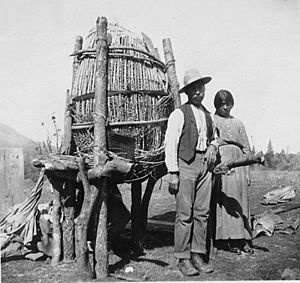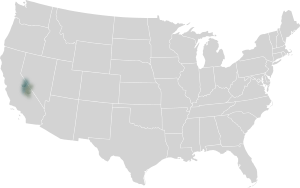Mono people facts for kids

A Mono couple living near Northfork, California, ca. 1920
|
|
| Total population | |
|---|---|
| approximately 2,300 | |
| Regions with significant populations | |
| United States (California and Nevada) | |
| Languages | |
| Mono language "Nim", English language | |
| Religion | |
| Traditional Tribal Religion, Christianity | |
| Related ethnic groups | |
| Northern Paiute, Shoshone |
The Mono people are a Native American group. They traditionally lived in the central Sierra Nevada mountains and nearby areas in what is now California and Nevada. They are sometimes grouped with the Paiute people, but the Mono are a distinct group.
Today, many Mono people live in North Fork, California, in Madera County. Other Mono people live across California, including the Owens Valley, the San Joaquin Valley, and the San Francisco Bay Area.
Contents
Who Are the Mono People?
The Mono people traditionally lived on both sides of the Sierra Nevada mountains. Because of this, they are divided into two main groups:
- Eastern Mono: These people lived on the eastern side of the Sierra Nevada, near the border of California and Nevada. They lived along the Owens River in the Owens Valley. They are also known as the "Owens Valley Paiute."
- Western Mono: These people lived on the western side of the Sierra Nevada foothills, near Mono Lake. They are also known as "Monache" or "Northfork Mono."
Even though they are sometimes called by different names, both the Eastern and Western Mono are part of the same ethnic group.
Mono Culture and Lifestyle
The name "Mono" comes from the Yokuts language, spoken by a neighboring tribe. The Yokuts called the Mono people "fly people" because they ate and traded fly larvae. However, this name was first used for a specific group, the Kucadikadi Northern Paiute Band, who were known for eating brine fly pupae. This group is often confused with the Mono people.
The Eastern Mono called themselves Numa or Nüümü, which means "People." The Western Mono called themselves Nyyhmy or Nim, also meaning "People."

Eastern Mono Lifestyle
The Eastern Mono lived on the California-Nevada border. They settled in fixed villages along rivers and springs. They even used artificial canals to help with farming. This allowed them to store food and support larger groups of people. Their villages were organized into "districts," each with its own leader.
The Eastern Mono lived in areas that bordered other tribes. They sometimes had conflicts with the Southern Sierra Miwok. They also fought against Americans in the "Owens Valley Indian War" (1862-1863) to protect their land. However, they usually had friendly relationships with the Northern Paiute, and many Eastern Mono people spoke both languages.
Today, several federally recognized tribes are part of the Eastern Mono, including:
- Big Pine Paiute Tribe of the Owens Valley
- Bridgeport Paiute Indian Colony of California
- Fort Independence Indian Community of Paiute Indians
- Lone Pine Paiute-Shoshone Tribe
- Bishop Paiute Tribe
- Utu Utu Gwaitu Paiute Tribe of the Benton Paiute Reservation
Western Mono Lifestyle
The Western Mono lived in the southern Sierra Nevada foothills and the San Joaquin Valley. They were mostly hunters and gatherers. They fished, hunted, and collected plants. In winter, several families would build settlements in river valleys. In summer, they would move to cooler mountain areas to hunt and gather.
The Western Mono often interacted with the Foothill Yokuts tribe. Some Western Mono groups became bilingual, meaning they spoke both Mono and Yokuts languages. They also adopted some of the Yokuts culture.
Some of the Western Mono groups included:
- Northfork Mono: This group lived along the San Joaquin River. They were quite isolated from other groups.
- Wobonuch: They lived in the foothills west of General Grant Grove, including parts of what is now Kings Canyon National Park.
- Entimbich: This group lived along the Kings River.
- Michahai: They lived along Cottonwood Creek.
- Waksachi: Their land was in Long Valley and along Eshom Creek.
- Balwisha: They lived along the Kaweah River tributaries, with some villages near Three Rivers, California. Sequoia National Park is in their traditional territory.
The North Fork Mono Tribe has two main clans: the golden eagle and the coyote. Many Mono traditions are still practiced today, such as fishing, hunting, gathering acorns, cooking, healing, making baskets, and playing traditional games.
The Sierra Mono Museum in North Fork, California, holds ceremonies. An annual Indian Fair Days festival takes place every August. This event helps keep traditions alive and is enjoyed by tribal members and visitors.
Mono Language
The Mono people speak the Mono language, also called "Nim." This language is part of the Western Numic branch of the Uto-Aztecan language family. Over time, two different dialects developed because of where the Eastern and Western Mono lived and their interactions with other tribes. These dialects are hard for speakers of the other dialect to understand.
A common Mono phrase is: Mun a hoo e boso. Mun a hoo e num. Mun a hoo to e hun noh pa teh. This means: "Hello to my friends. Hello to the Mono people. Hello to the people from all over."
Sadly, the Mono language is in danger of disappearing. Only a small number of people still speak it fluently.
Mono Population Today
Historians have estimated the number of Mono people before European contact. Some suggest there were about 4,000 Mono people in 1770. By 1910, the population was reported to be around 1,500.
Today, there are about 2,300 enrolled Mono Indians. The Cold Springs Mono tribe has 275 members. The Northfork Mono's enrollment is 1,800, making them one of California's largest Native American tribes. The Big Sandy Mono tribe has about 495 members.
See also
 In Spanish: Mono (tribu) para niños
In Spanish: Mono (tribu) para niños



